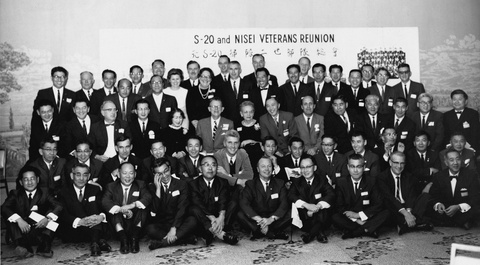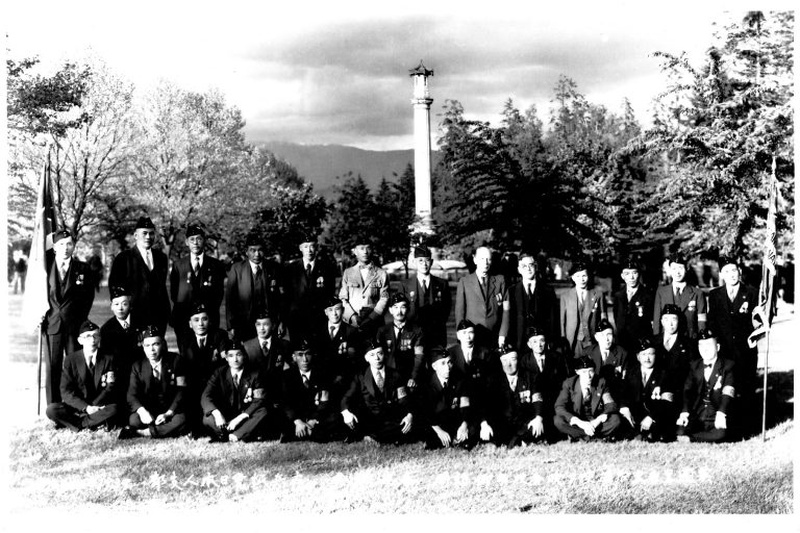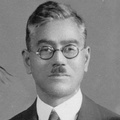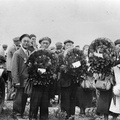Introduction
To prove their loyalty to Canada, two generations of Nikkei fought in the World Wars to gain rights for their community. The first generation, the Issei, served in World War I. The second generation, the Nisei, served in World War II, as well as the Korean and Vietnam Wars. This article focuses on Canadian Nikkei participation in the two World Wars.
Asian Immigration to Canada
The first known Japanese immigrants arrived in 1877. Almost all Japanese immigrants settled in British Columbia (B.C.), working as fishermen, loggers and labourers in sawmills. British Columbia had a landscape similar to Japan’s, but much richer in natural resources. Few crossed east of the Rockies. In 1907, immigration increased, with 8,125 Japanese, 1,300 Chinese and 2,000 East Indians arriving in B.C. (Adachi, 1976, p. 70). These arrivals caused unease among the white population. Racist politicians perceived these new arrivals as a threat and created the Asiatic Exclusion League. In B.C., people of Asiatic origin were prevented from working in professions or holding positions in Parliament. The greatest dishonour was the denial of the vote to those from Japan, China, India, and even to Canadian Aboriginals.
First World War
Many Canadians would be surprised to learn that Japanese Canadians fought in the First World War. Over 200 Japanese Canadians volunteered for the Canadian Army. They wanted to prove their loyalty to their adopted country, where they experienced racism in their day-to-day lives. They believed that fighting for their new homeland would prove their loyalty as Canadians, which would in turn grant them the right to vote (Kishibe, 2016). The Canadian Japanese Association, representing Japanese in Canada, organized training for the group between January and March of 1916 in Vancouver. Their offer of service was rejected in B.C., but in Alberta, Issei and some Nisei volunteers joined Canadian battalions of the British Army and were sent to Europe to fight. Fifty-four of these men did not survive the war, and 92 were wounded. Thirteen were awarded Military Medals for Bravery. They fought in major battles such as Vimy Ridge, Hill 70, the Somme and Passchendaele. On April 9, 1920 (the third anniversary of the Battle of Vimy Ridge), a cenotaph was unveiled at Stanley Park in Vancouver honouring the Japanese Canadians who fought in World War I. It was built, at a cost of $15,000, solely from donations from the Japanese Canadian community (Dick, 2010, p. 457).
It wasn’t until April 1, 1931 that, by just one vote, the B.C. Legislature granted the franchise to First World War veterans of Japanese origin (Shinobu, 1931, Sunahara and Oikawa, 2015, Greenaway, 2013). The veterans became the first Asians allowed to vote in Canada. This was through the intense and persistent efforts of four Issei (three of them WW1 veterans) who went to Victoria to lobby the members of the Legislature after years of planning. It was a bittersweet moment for the veterans, who had struggled for so long on and off the battlefield. Finally they were able to vote, but the rest of the Japanese Canadian population (including descendants of the veterans) remained disenfranchised.
In the same year, Japan seized control of Manchuria. Poised for imperial expansion, Japan withdrew from the League of Nations, signed treaties with Germany and Italy in 1937 and then commenced open war with China.
Once atrocities committed by Japan in China became public knowledge, west coast Canadians became increasingly suspicious of Japanese Canadians. In Vancouver, there were boycotts of Japanese products and loud anti-Japanese demonstrations. B.C. politicians shouted: “They are the enemy; they have to be watched; they are not to be trusted; they should be controlled”. Roy Ito, in his book We Went to War, explains “The Nisei were caught between two worlds. In Japan they were foreigners; white Canadians thought of them as Japanese” (Ito, 1984, p. 100).
Second World War
In 1939, when Canada declared war against Germany, the Japanese Canadian newspaper, The New Canadian, devoted a full page covering the Issei who had fought for Canada during the First World War. Nisei were reminded of the sacrifices made, including the 54 who did not return.
The Japanese Canadian Citizens League sent a telegram to Prime Minister Mackenzie King that pledged loyalty and offered the services of all Japanese Canadians to the war effort (Ito, 1984, p. 107). The Nisei had the chance to serve their country as the Issei had, and to prove that they were loyal Canadians.
On December 7, 1941, Japan attacked Pearl Harbor. On February 24, 1942, an order-in-council gave the federal government the power to intern all “persons of Japanese racial origin”. Around this time, the flame atop the Japanese Canadian War memorial in Stanley Park was extinguished. It was not relit until 1985 (Wakayama, 1985). B.C. Japanese Canadians were interned in prison camps, sent to road camps, sugar beet farms or POW camps. Issei veterans from the First World War were among those interned.
From 1942 until 1945, Nisei were banned from participating in the Canadian Forces, although many tried very hard to enlist. Despite the ban, 32 Nisei served in the Canadian military at this time. Nisei outside of B.C. had been able to enlist before Pearl Harbor. Many experienced combat in Europe. Some were the sons of Issei First World War veterans.
In 1944, the High Command intensified its campaign in the South Pacific. Demand for Japanese Canadians in the Forces came from outside Canada. Australia and Britain were in dire need of Japanese-speaking translators in Southeast Asia to question Japanese POWs and to translate Japanese documents. Canada was the only country in the British Empire with any Japanese-speaking population. When Japanese Canadians volunteered to go to war, they were urged to sign up as members of the British army so that they could not demand the vote when they returned from the war. Twelve Japanese Canadians volunteered in this way. There was no guarantee that they would be allowed to keep their Canadian citizenship on their return.
Under pressure from the British War Office, in January 1945, the Canadian War Cabinet reluctantly agreed to enlist Japanese Canadians. Enlistment began in March in Toronto. Many of the recruited Japanese Canadians had been interned by the government they were pledging to serve. Some Nisei that signed up were disowned by their families, who were very bitter over the internment (Broadfoot, 1977). The greatest regret of the recruits was that enlistment was for linguistic purposes only. Nisei recruits were placed in two groups – the so-called “India group” under the British officer Captain Mollison, and the S-20 group. The India group included the 12 who had previously volunteered, plus 23 who were sent to India soon after (Oki, 1967).
The S-20 group of 51 received four months of basic training in Brantford, Ontario, plus Japanese language training at Vancouver’s Canadian Army Japanese Language (S-20) School. Vancouver was by this time empty of Japanese Canadians. Of the school’s 230 graduates, 60 were Nisei. Although their Issei parents spoke Japanese, less than 25% of Nisei at the language school could speak Japanese when they began their studies.
Just two drafts of qualified graduates from the S-20 school saw overseas service. They worked in the Far East theatre with the War Crimes Investigation Force and the U.S. occupation in Japan. A few Nisei worked in Washington D.C.
Thirty Nisei graduates of the S-20 and a similar number of Nisei (the India group) served in India, Burma, Siam, the Dutch East Indies, French Indochina, Hong Kong, Japan, Singapore, and Malaya, sometimes with the British Forces Southeast Asia Command (SEAC). Their jobs included interrogating surrendered Japanese soldiers (to determine whether they had committed war crimes), psychological warfare, broadcasting of radio messages, intelligence gathering, translating and interpreting documents (Oki, 1967). They worked on ships, in courtrooms and at temporary camps set up in the jungle.
When the Nisei returned home after their war service, they still faced the same government restrictions as before. The War Measures Act was still in place, and their government still considered them "enemy aliens." At the end of the Second World War, Japanese Canadians were given two choices: disperse east of the Rocky Mountains or be “repatriated” to Japan (Ito, 1984). Unlike interned Japanese Americans, the Canadian internees were not permitted to return to their homes (most of which were in BC) at the end of the war. Most settled east of the Rockies. In 1946, almost 4000 former internees (about 2000 of whom were aging Issei and 1300 of whom were children under 16) were sent to Japan. They arrived in a wasteland ravaged by bombs and food shortages. Many had never set foot in Japan before.
Canadian opinion on Japanese Canadians was starting to change after the war. The government’s deportation policy was met by protests from organizations including journalists, civil libertarians and church groups. In 1947, the Federal Cabinet revoked the legislation to deport the remaining Japanese Canadians, (Canadian Race Relations Foundation, undated).
In 1948, Japanese Canadians were granted the right to vote federally. In March 1949, they were granted the right to vote provincially in B.C. A week later, they were free to return to B.C. Few possessed the means or inclination to return there. The provincial franchise had long remained an impossible dream for Japanese Canadians. No one expected it to be granted so suddenly.
Was it the service of the Nisei that achieved the franchise for all Japanese Canadians? That is unlikely. After the war, changes swept through Europe, Asia, Africa, the Americas, and Canada. Roy Ito, in his book We Went to War, says: “In the newly created United Nations, Canada pledged to support fundamental human rights, the dignity and worth of the human person, and the equal rights of men and women. Racial prejudice and animosity were no longer popular”.
While the franchise wasn’t earned directly through the service of the Canadian Nisei, their story is still worth telling. Despite experiencing prejudice and alienation by their own country, they chose to follow the path of Issei soldiers, on a quest to be treated equally as Canadians. They wished to prove their loyalty to Canada, and that’s exactly what they did.

References:
Adachi, Ken, “The Enemy That Never Was: History of Japanese Canadians” Toronto: McClelland & Stewart, 1976
Broadfoot, Barry, “Years of Sorrow, Years of Shame – the Story of the Japanese Canadians in World War II”, 1977, PaperJacks Ltd., Don Mills, Ontario, 370 pp.
Canadian Race Relations Foundation, “From Racism to Redress: The Japanese Canadian Experience”, undated
Dick, Lyle, "Sergeant Masumi Mitsui and the Japanese Canadian War Memorial: Intersections of National, Cultural, and Personal Memory", The Canadian Historical Review, 91, 3, September 2010, University of Toronto Press Incorporated, pp. 435-463.
Greenaway, John Endo, "They Went to War: Japanese Canadians and the Battle for Acceptance", The Bulletin, Nov 9, 2013.
Ito, Roy, “We Went to War: The Story of the Japanese Canadians Who Served During the First and Second World War”, Canada's Wings, First Edition, 1984, 330 p.
Kishibe, Kaye, "Our Conscription Crisis", Nikkei Images, (Publication of the Nikkei National Museum & Cultural Centre) ISSN #1203-9017 Fall 2016, Volume 21, No. 3
Oki, Jack, “The Canadian Nisei Veteran's Story”, New Canadian Newspaper, December 27, 1967, Library and Archives Canada Source: Box MG-V7, Volume 18, file 18-10 “Army Volunteers”
Shinobu, Saburo, “Saburo Shinobu Memoirs, 1931”, Library and Archives Canada Source: MG28-V7, Volume 18, File 18-31 ISSEI franchise bid—Notes, clippings, 1920-1931.
Sunahara, Ann and Oikawa, Mona, “Political Activism - Seeking the Vote”, The Canadian Encyclopedia, April 26, 2017.
Wakayama, Tamio, "Lest We Forget: A Dedication to Commemorate the Re-lighting of the War Memorial to Japanese Canadian Soldiers of World War I, August 2, 1985", Reproduced in Nikkei Images, Autumn 2005, Vol. 10, No. 3, pp. 5-6.
*This article was originally published on Nikkei Voice on November 13, 2017 and updated on Discover Nikkei on March 19, 2019.
© 2017 Susan Yatabe and Ewan Craig







